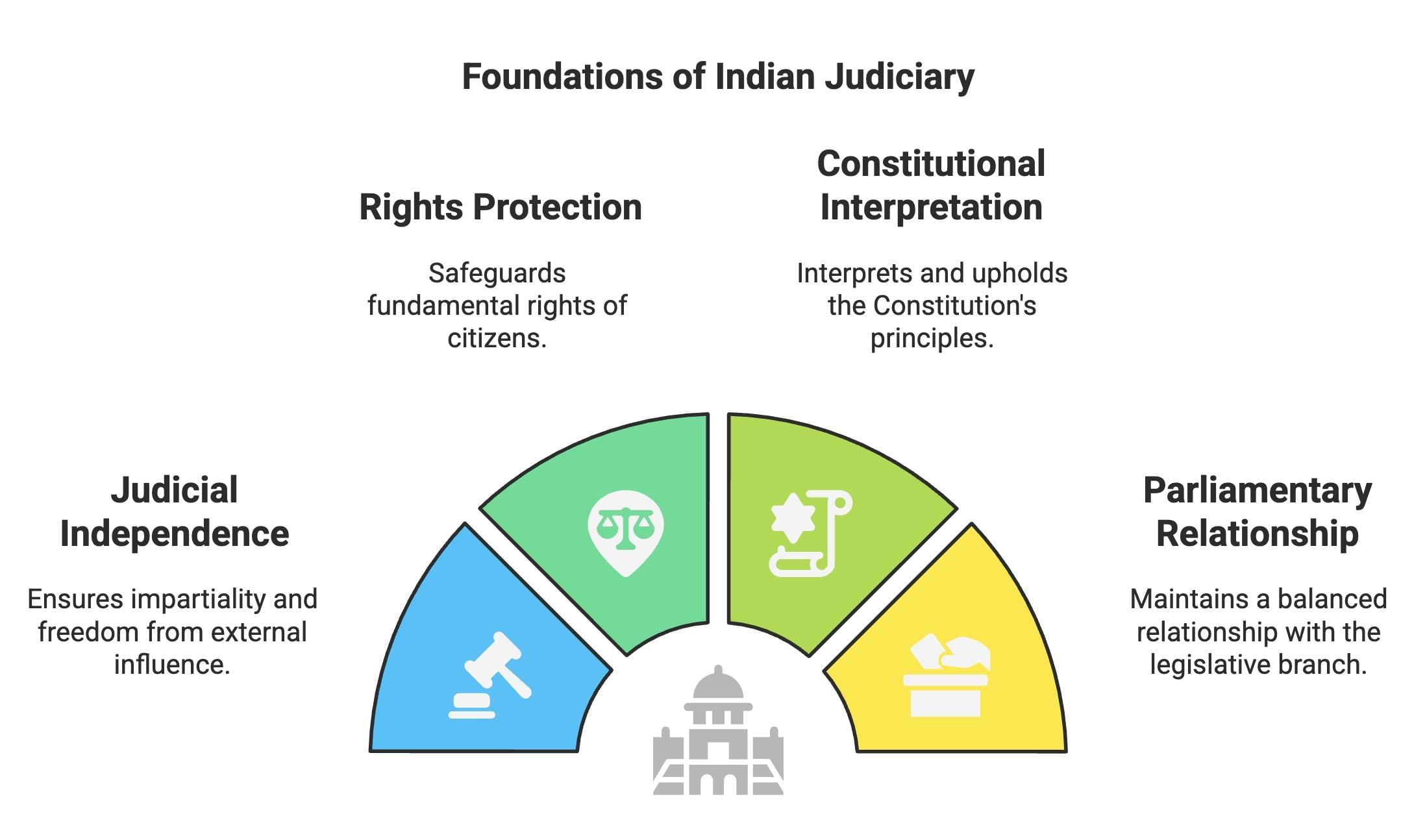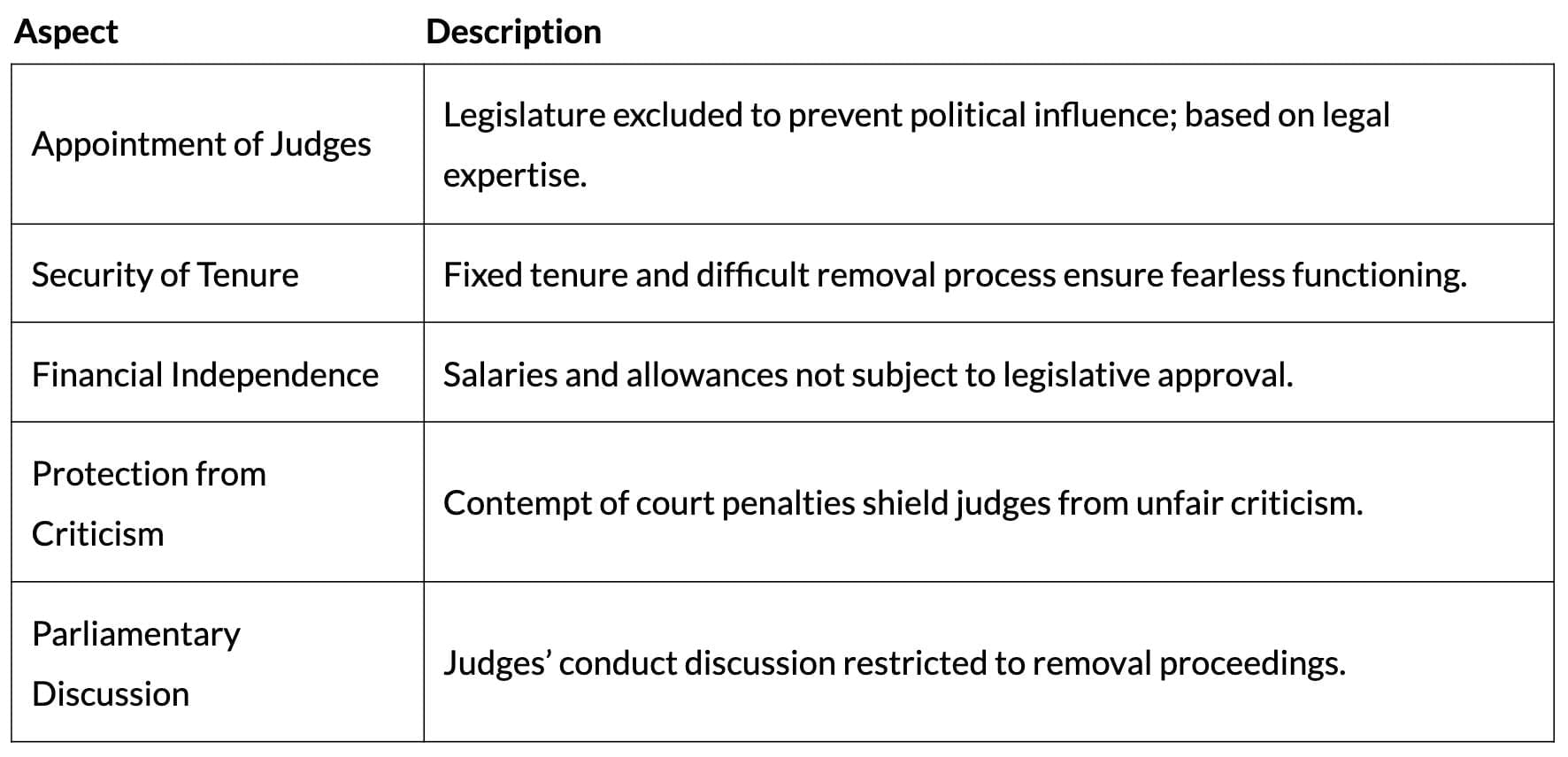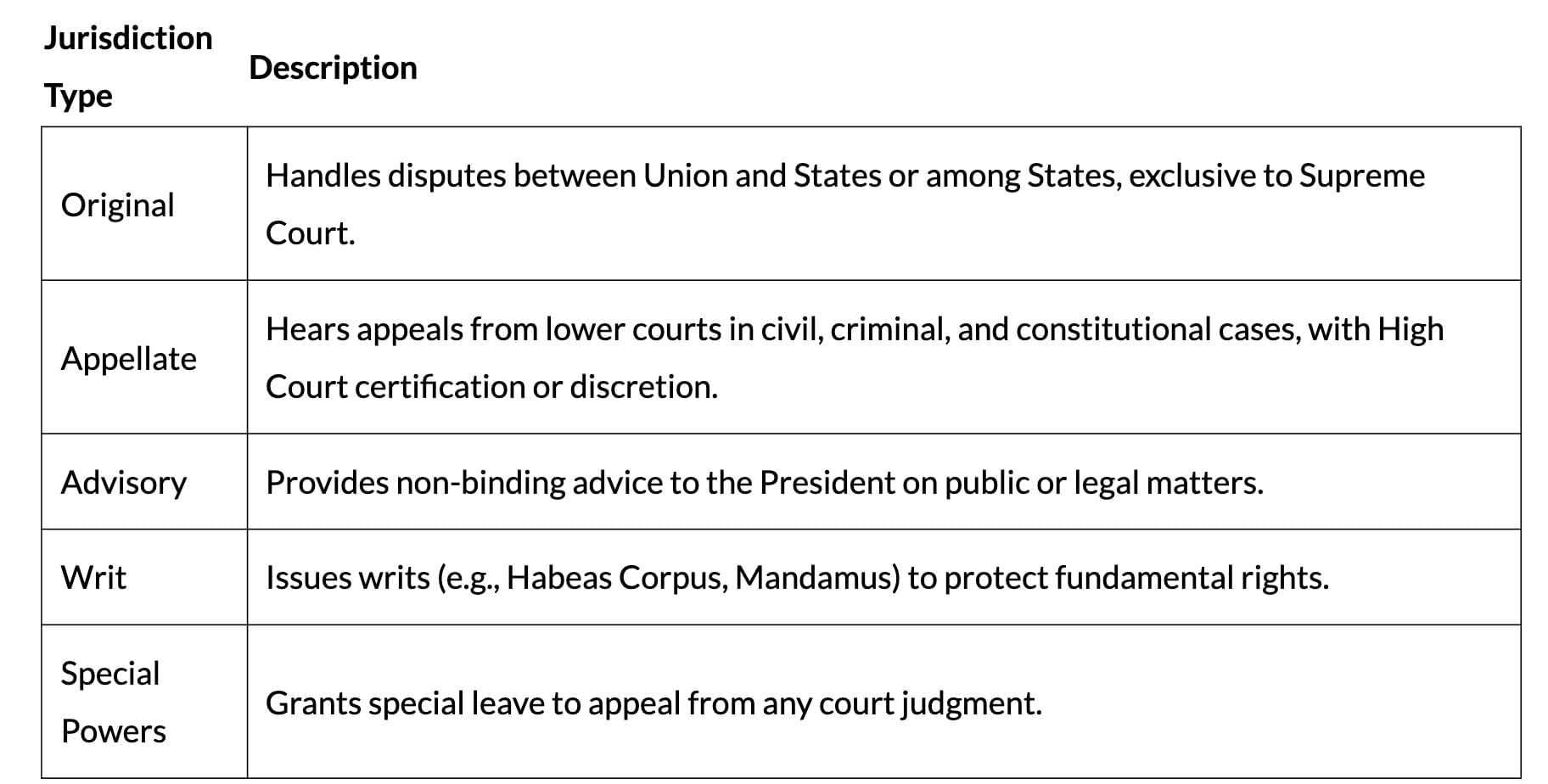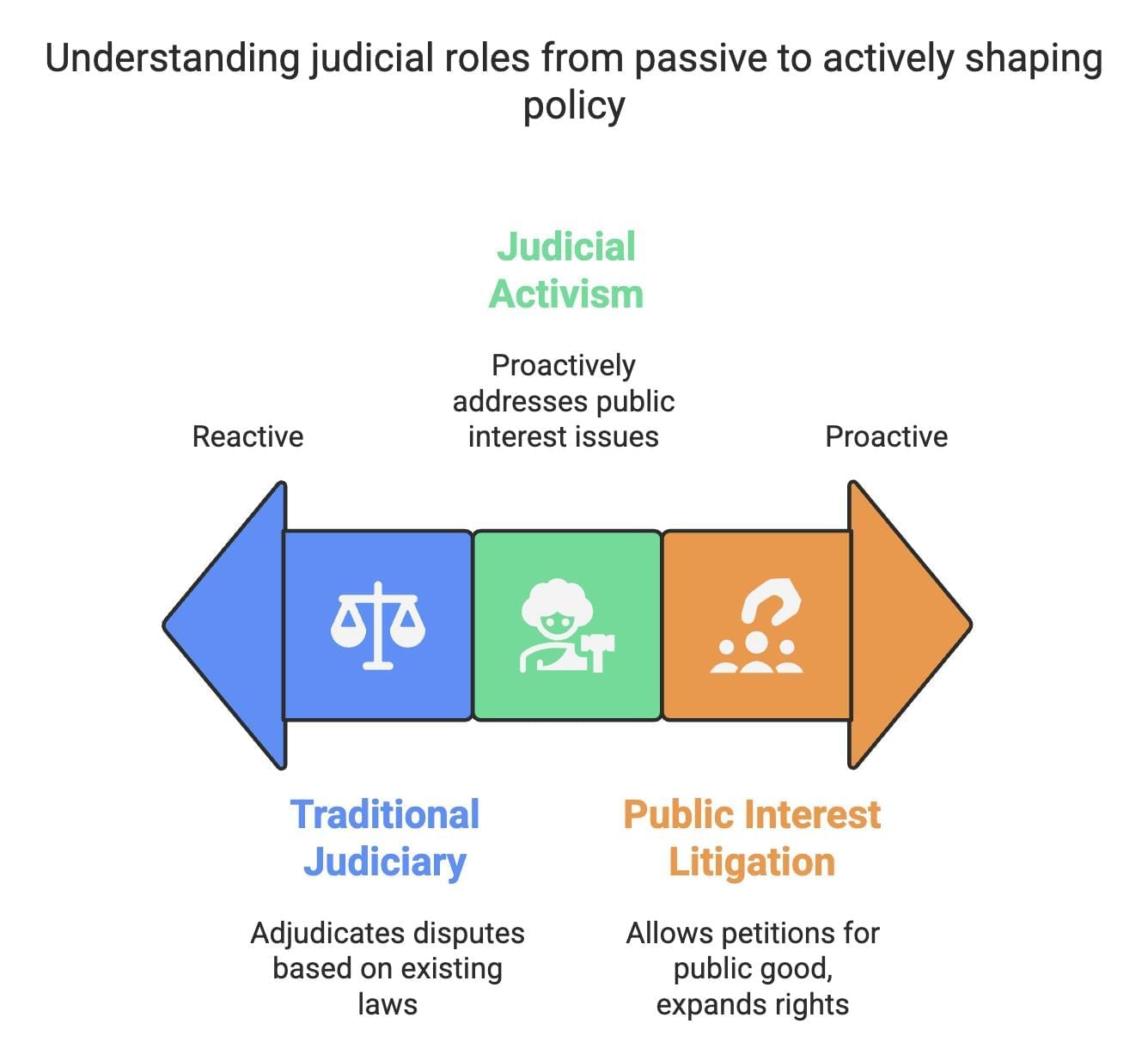Revision Notes: Judiciary | Political Science Class 11 - Humanities/Arts PDF Download
The judiciary, particularly the Supreme Court of India, is a vital government institution, mediating disputes and performing political functions. Since 1950, it has interpreted and safeguarded the Constitution, protecting fundamental rights and maintaining democratic balance. This chapter explores judicial independence, its role in rights protection, constitutional interpretation, and its relationship with Parliament.

Why Do We Need an Independent Judiciary?
- Dispute Resolution: Resolves conflicts between individuals, groups, or government entities impartially, following the rule of law.
- Rule of Law: Ensures everyone is equal before the law, regardless of status, upholding legal supremacy.
- Protection of Rights: Safeguards individual rights, settles disputes legally, and prevents dictatorial tendencies.
- Need for Independence: Freedom from political pressures ensures fair, impartial justice, upholding the rule of law and rights protection.
Independence of Judiciary
Meaning
Judicial independence means the executive and legislature cannot interfere with judicial decisions, allowing judges to act without fear or favouritism.
Accountability
Independence does not imply arbitrariness; the judiciary is accountable to the Constitution, democratic traditions, and the people.
Ensuring Independence

Appointment of Judges
Political Controversy
Judicial appointments are politically sensitive, as judges’ philosophies impact constitutional interpretation. Political figures (e.g., Council of Ministers, Governors, CJI) influence the process.
Chief Justice of India (CJI)
- Traditionally, the senior-most judge is appointed CJI.
- Conventions broken in 1973 (A.N. Ray) and 1975 (M.H. Beg), superseding senior judges.
Other Judges
- Appointed by the President after consulting the CJI, whose advice is binding.
- Collegiality: CJI consults four senior-most judges for recommendations, which carry significant weight.
Role of the Supreme Court and the Council of Ministers
Both entities balance power in appointments, with Supreme Court recommendations holding strong influence.
Removal of Judges
- Process: Judges can be removed only for proven misbehaviour or incapacity via a special majority in both Houses of Parliament.
- Special Majority: Requires higher agreement than a simple majority, ensuring consensus.
- Historical Case (1991): Justice V. Ramaswami’s removal motion for fund misappropriation failed due to Congress's abstention, despite a two-thirds majority among voters.
Structure of the Judiciary
India has a single integrated judicial system, organised pyramidally:
- Supreme Court: Apex court.
- High Courts: Below the Supreme Court, overseeing lower courts.
- District and Subordinate Courts: Base level, under higher court supervision.
Jurisdiction of the Supreme Court

Articles 137 and 144
- Article 137: Allows review of Supreme Court judgments for errors.
- Article 144: Mandates all authorities to aid the Supreme Court's orders.
Binding Nature
Supreme Court decisions bind all lower courts, but the Court can review its own rulings. It also handles contempt of court cases.
Judicial Activism and Public Interest Litigation (PIL)
Judicial Activism
Judiciary proactively addresses public interest issues, shifting from reactive to active roles based on societal concerns.
Public Interest Litigation (PIL)
- Allows petitions on behalf of those unable to represent themselves, addressing public interest issues.
- Emerged in 1979; landmark cases include Hussainara Khatoon (1979) and Sunil Batra (1980).
- Expanded rights to include clean air, water, and decent living conditions.
Impact
- Democratised justice, enhanced executive accountability, and improved electoral transparency (e.g., candidate disclosures).
- Global acceptance in South Asia and Africa, notably South Africa’s Constitutional Court.
Criticism
- Overburdens courts and blurs the separation of powers by intervening in executive domains (e.g., pollution, corruption).

Judiciary and Rights
- Restoring Rights: Issues writs under Article 32 (Supreme Court) and Article 226 (High Courts) to restore fundamental rights.
- Declaring Laws Unconstitutional: Strikes down laws under Article 13 if they violate the Constitution.
- Judicial Review: Assesses the law's constitutionality, implied by the Constitution’s written nature, protecting rights and federal balance.
- Right Against Exploitation: Prohibits forced labour, human trafficking, and child labour; PILs address violations (e.g., police brutality, poor working conditions).
Judiciary and Parliament
Judicial Review
Ensures constitutional compliance by reviewing actions of the President, Governor, and political practices.
Judicial Activism
Directs executive actions (e.g., CBI investigations in hawala scandal, Narasimha Rao case).
Separation of Powers
- Parliament: Makes laws, amends the Constitution.
- Executive: Implements laws.
- Judiciary: Settles disputes, ensures constitutional compliance.
Conflicts
- Early Disputes: Parliament’s restriction of property rights for land reforms; the judiciary upheld fundamental rights’ sanctity.
- 1967–1973: Escalated over preventive detention, job reservations, and property acquisition.
- Kesavananda Bharati Case (1973): Established the Constitution’s basic structure doctrine, allowing property rights abridgement but protecting core principles.
Ongoing Issues
- The judiciary regulates legislative functions, protects individuals from legislative discipline and mutual criticisms, causing tensions.
Conclusion
The Indian judiciary, particularly the Supreme Court, is a powerful, independent institution safeguarding rights and interpreting the Constitution. Despite tensions with Parliament and the executive, its prestige has grown. Judicial activism and PILs have expanded justice access, but challenges like case overburdening and power balance concerns persist. Democracy relies on mutual respect among government organs, with the judiciary ensuring constitutional limits are upheld.
|
44 videos|399 docs|50 tests
|
FAQs on Revision Notes: Judiciary - Political Science Class 11 - Humanities/Arts
| 1. Why is an independent judiciary important for a democratic society? |  |
| 2. How are judges appointed to the judiciary, and why is this process significant? |  |
| 3. What is the process for removing judges from their positions? |  |
| 4. What is the jurisdiction of the Supreme Court in a national judiciary system? |  |
| 5. How does judicial activism relate to public interest litigation (PIL)? |  |
















